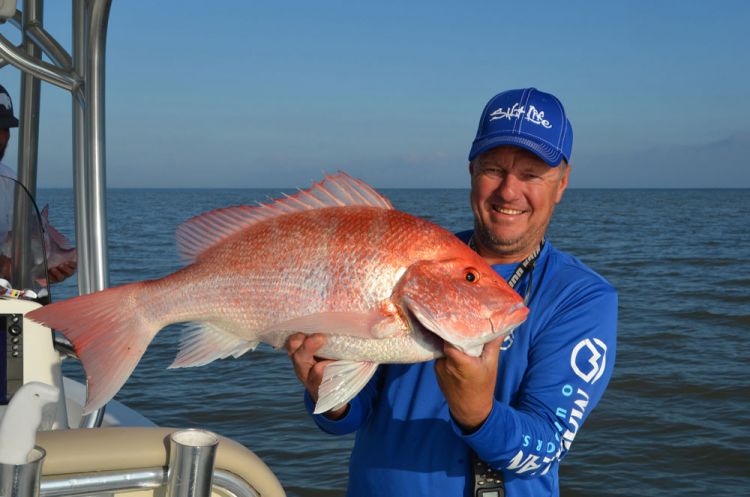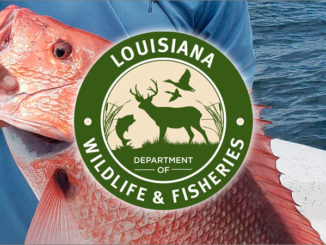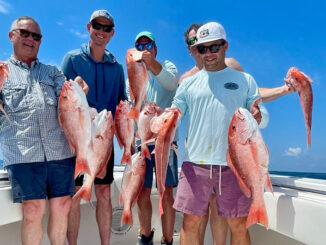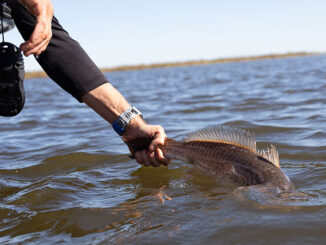Without oil platforms or reefs, wrecks and rock piles on the bottom, see how this Venice guide locates red snappers in open water using nothing but his electronics.
Everything about this screamed “wrong” to a Louisiana red snapper fisherman.
Nothing was in near sight — no oil platform; just open water. And a look at the depth sounder’s screen showed nothing but seemingly barren mud bottom — no wreck; no reef; no rock pile.
Nothing.
On top of that, the water was the color of liquid dust. And in the distance, I could still see land.
I thought that red snapper fishing was supposed to be offshore fishing — you know, long boat rides and blue water.
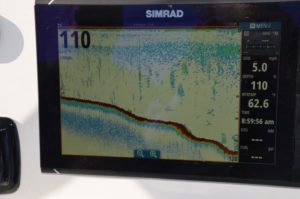
But not to Scott Pelas.
Working out of Venice, the charter fishing guide (Louisiana Lagniappe Charters, 504-460-1687) has made a specialty of doing combo trips targeting speckled trout and redfish inshore, and red snappers offshore in the same day.
After a snug night at Port Eads, the modern version of the famous and historic New Orleans Big Game Fishing Club’s home, Pelas headed down South Pass of the Mississippi River toward the open Gulf of Mexico.
Pelas has served as an on-again, off-again right hand man at the marina, mixing some responsibilities there with his full-time charter fishing business.
With him was the general manager of the marina, Travis Yates, originally from North Myrtle Beach, South Carolina. Yates had fallen in love with South Louisiana’s deep marshes.
“Just the experience of being down here is special. It’s like being at the edge of the Earth. At night, you see stars and rig lights instead of street lights and headlights.”
The evening before the trip was utterly peaceful. The river slipped silently past the spacious dock, carrying pieces of North Dakota, Ohio, and 29 other states through a vast meadow of 8-foot tall roseau canes.
A state expedition
Before the trip, Pelas had explained to me he originally learned the art of finding and catching red snapper within state waters off the mouth of the Mississippi River to take advantage of much more liberal season dates — and the unique geographical features that make Venice one of the few places on the coast where you can really target snapper effectively out to the state boundary — 10.356 miles.
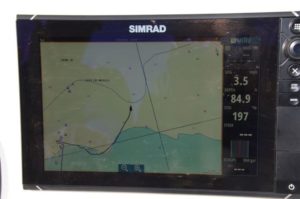
That’s because the mouth of the river juts far out into deep water. Going from 2 to 5 miles offshore of the river delta, water depths drop from 55 to 200 feet deep, Pelas explained. By 7 miles out, it is 400 feet deep and at 12 miles it’s 1,000 feet.
Red snappers are seldom found in depths shallower than 50 feet deep, or deeper than 300 feet. Because bottoms drop so sharply off the mouth of the river, the “magic zone” for snappers is very narrow, and accordingly few oil and gas platforms are there for fishermen to target.
Those that exist are hammered by anglers. Being able to locate the fish on natural bottoms gives a huge leg-up to those able to do so.
Red snapper-depth waters are closer to land out of Venice than anywhere else in the state. So having the skills to find and catch them within sight of land puts the fishery within easy reach of bay boat owners.
“As for the surface water color, don’t let that fool you,” comforted Pelas. “Lighter, muddy water from the (Mississippi) river layers over heavier, clear, salty Gulf water underneath. That’s where the snappers are.”
Reading the bottom
Red snappers are invariably thought of as fish that prefers rocky or reef-like bottoms. Very little such bottom exists offshore of the mouth of the Mississippi River. Almost everything is smothered in a thick blanket of mud — the result of the sediments carried to the Gulf by the Mississippi River.
But the lack of hard bottom does not deter Scott Pelas. He is more concerned with bottom contours and ledges than bottom type. The ledges may not be classic rocky ledges, but they exist nonetheless.
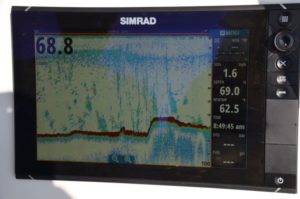
These ledges are formed by bottom water currents, but at the same time and even more importantly, they channel water currents.
Pelas watched his depth sounder closely when he got to 65-foot depths. What he was looking for were the keys to his success, what he called “nipples” — contour indentations from deeper water into shallower water.
“These work as natural funnels for water currents to drive bait species into concentrations,” he explained. “Where the food is, is where the snappers are.”
The rest was ridiculously easy. They sent their baited hooks to the bottom and reeled up four or five cranks. It seemed the bait hardly settled into place before a fish took it.
Because of the shallow water, none of the fish had stomachs shoved out of their mouths by air bladders, an effect of decompression that occurs in deep-water fish. This allowed Pelas and Yates to cull their fish, only keeping the largest. Even with heavy culling, it was all over in 20 minutes.
Rigging up
Pelas’ reels were spooled with 80-pound-test braided line and 18- to 24-inch, 200-pound-test monofilament leaders, fairly typical for red snapper fishing. Everything was secured with Palomar knots.
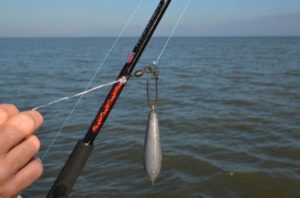
His terminal rigs showed a wrinkle that he called, “right out of Ed Sexton’s playbook.” Sexton is best-known for being one of the featured trophy speckled trout anglers in the book Trout Masters: How Louisiana’s Best Anglers Catch the Lunkers.
The braided main line was tied directly to the eye of the snap swivel’s snap, rather than to the eye of the swivel. The hook-bearing mono leader was then tied to the swivel and the weight was snapped into the snap.
“This rig allows you to remove the weight for the run out so the weight doesn’t bang against the rod in a bouncing, running boat,” he explained.
He baited each big 6/0 Eagle Claw circle hook with squid. “Cut bait works well, too — anything: trout bellies, herring, mullet. But I like squid. You get less sharks, and it stays on the hook better than cut bait.”
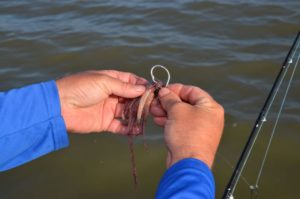
Hook, line, and sinker aside, Pelas considers his most important open water red snapper tool after his depth sounder to be his Minn Kota I-Pilot trolling motor. Simply by hitting the “anchor” button on his control, he is assured the boat will stay on position without further tending.
“Having one is extremely important to stay on the fish once you have found them,” he stressed. “If you don’t, you will drift aimlessly. You catch one and then drift off the spot.
“Be sure to keep the latitude and longitude readings when you find fish. They tend to concentrate in the same spots. Sometimes red snappers will suspend up in the water column, but they will still be in the same place.
